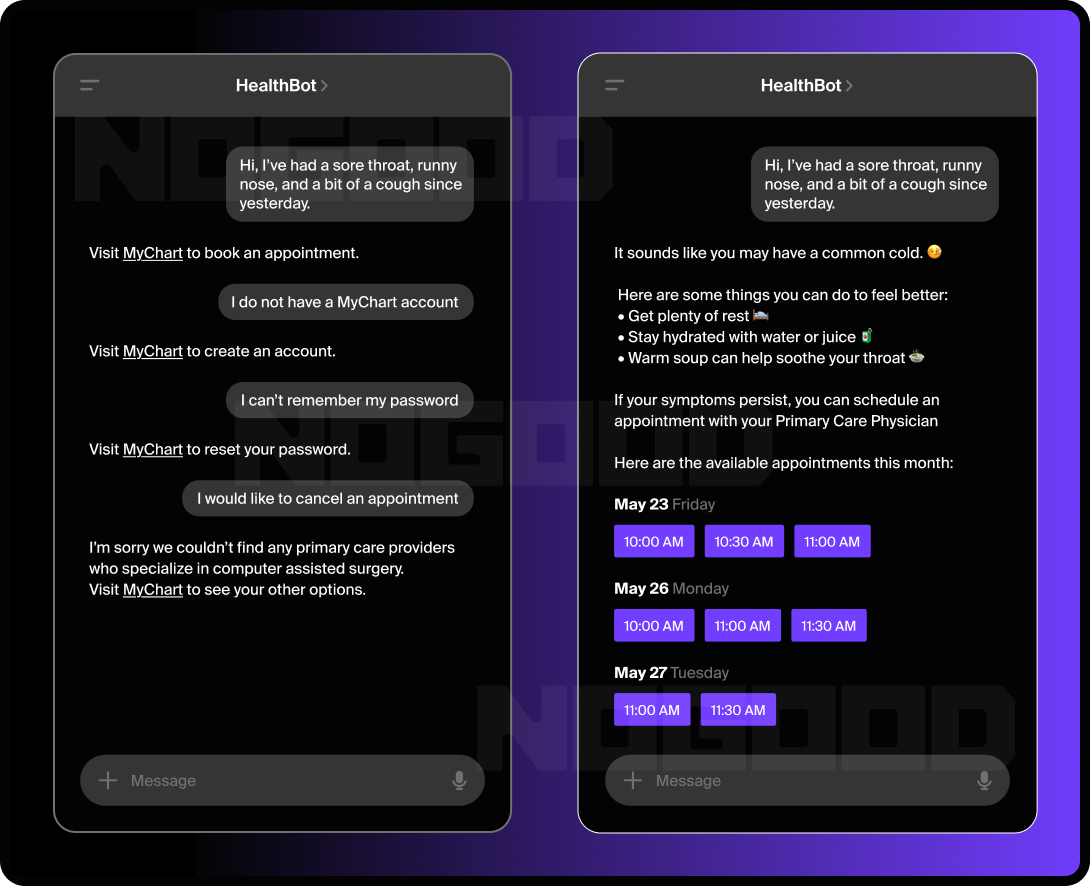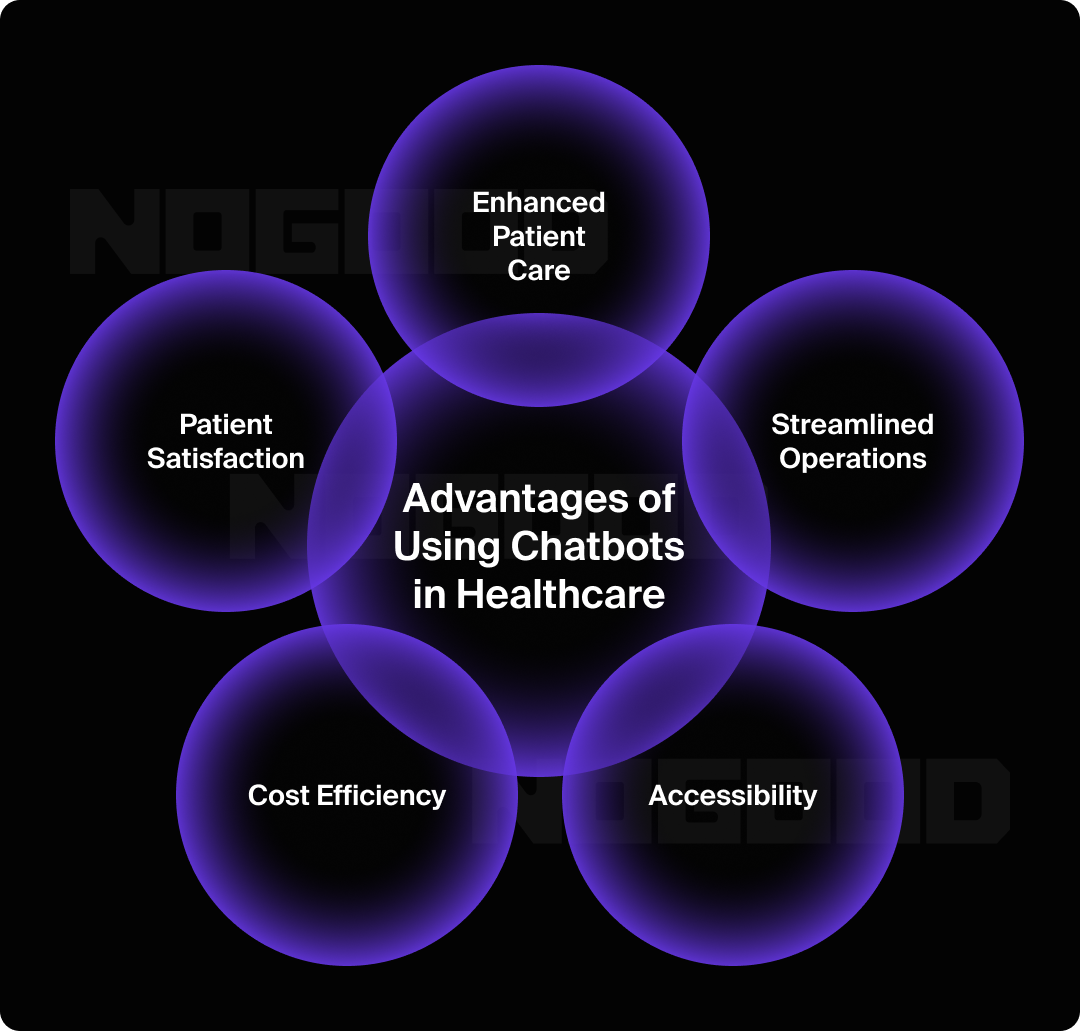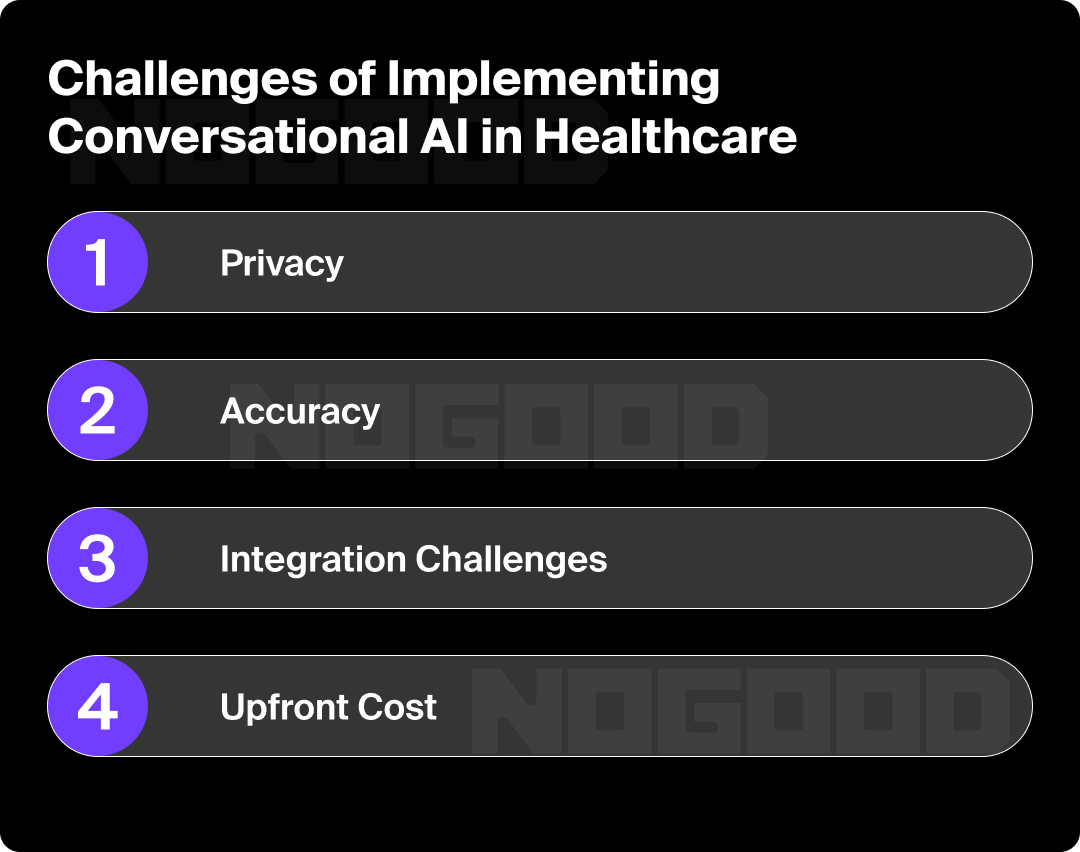Patient expectations are evolving—and fast. Healthcare organizations are no longer just competing on clinical outcomes; they’re being measured by the quality of their digital experiences. Enter conversational AI: a technology redefining how providers, payers, and healthcare brands engage with patients across the care journey.
Far more advanced than the chatbots of yesterday, conversational AI uses natural language processing (NLP) and machine learning (ML) to deliver intelligent, human-like interactions at scale. From streamlining operations and boosting patient engagement to enabling scalable personalization, it’s quickly becoming a game-changer in modern healthcare.
We’ll explore the benefits, use cases, and strategic opportunities conversational AI brings to healthcare, along with the challenges and practical steps to get started.
It’s Not Just Chatbots Anymore, It’s a New Patient Experience

Leveraging conversational AI in healthcare applications means evolving from traditional chatbots. Traditional static chatbots follow a predefined script. While they can assist users in simple tasks such as appointment reminders, scheduling, and directing users to different website pages based on queries, they’re limited to those interactions.
But conversational AI learns and adapts. They can process complex queries and understand nuances in patient language.
Conversational AI is smarter than traditional chat systems and healthcare applications, meaning patients can describe their symptoms as if they’re talking to a nurse. Then, they’ll receive informed, contextually relevant responses that consider medical history, medications, and even lifestyle changes.
This delivers meaningful patient support and reduces reliance on symptom-checking through generic search engines, where worst-case scenarios often top the results. Instead of fielding anxiety like the all-too-familiar “WebMD told me I’m dying” meme, conversational AI can offer grounded, personalized guidance that builds trust and encourages more proactive care.
Additionally, conversational AI systems are designed to integrate seamlessly into existing healthcare infrastructures. They work in tandem with electronic health records (EHRs), patient management systems, and other digital tools to ensure that the information provided is accurate and up-to-date.
The Marketing Opportunity Behind Smarter Patient Conversations
Conversational AI isn’t just a clinical tool, it’s a brand experience engine. For healthcare marketers, it delivers 4 key benefits that transform how you connect with and support patients:
- Scalable Personalization: Deliver tailored content, guidance, and support to thousands of patients, automatically and empathetically.
- Omnichannel Consistency: Extend your brand voice across chat, SMS, voice, and app interfaces, meeting patients where they are.
- Data-Driven Insights: Capture rich, first-party data from real-time interactions to optimize the patient journey.
- Loyalty Through Empathy: Build deeper patient trust through responsive, human-like interactions that feel genuinely helpful.
Benefits of Leveraging Conversational AI in Healthcare

Enhancing Patient Care
Conversational AI offers healthcare organizations a way to enhance patient care and operational efficiency, the most significant advantage being improved patient engagement. Through personalized interactions, meaningful communication between patients and healthcare providers can be facilitated. This helps boost patient satisfaction and encourages users to be active participants in their health management.
Streamlining Operations
Streamlining operations is another major benefit of using conversational AI within healthcare platforms. Conversational AI can be programmed to automate various administrative tasks, from appointment scheduling to prescription refills, drastically reducing the burden on healthcare staff. This automation frees up valuable human resources, allowing them to focus on more complex patient care tasks. Moreover, it minimizes the risk of human error in routine processes, ensuring smoother and more reliable administrative operations.
Cost Efficiency
Cost reduction is another compelling advantage that cannot be overlooked. Minimizing the need for human intervention in routine inquiries and tasks can significantly cut operational costs. Resource allocation becomes more efficient, allowing for better utilization of both human and technological assets. This cost-effectiveness is particularly beneficial for smaller healthcare providers operating with tighter budgets.
Accessibility
Accessibility to care is greatly enhanced with conversational AI. These systems can provide 24/7 support, ensuring patients can access necessary information and assistance whenever they need. This round-the-clock availability is critical for patients who may require immediate answers or support outside of regular office hours. Additionally, data-driven insights garnered from AI interactions empower healthcare providers to gain a deeper understanding of patient needs and behaviors, leading to more informed decision-making.
Improved Patient Satisfaction
Conversational AI enhances patient satisfaction by making care more accessible, personalized, and empathetic. It provides real-time support across chat, voice, and SMS, reducing wait times and improving convenience. Unlike static chatbots, it adapts to patient needs, remembers past interactions, and delivers warm, human-like responses.
By streamlining communication, minimizing errors, and proactively offering guidance, AI helps patients feel supported, informed, and cared for every step of the way.
Scalability
Another impactful advantage of conversation AI in healthcare is its scalability. Unlike human staff, AI can handle thousands of patient interactions simultaneously without compromising quality or consistency. This makes it possible for healthcare organizations to extend support beyond normal business hours, manage high volumes during peak times, and serve growing patient populations without a proportional increase in overhead.
Omnichannel Consistency
Today’s patients interact with healthcare companies across multiple touchpoints, including the web, mobile apps, SMS, voice assistants, and more. Conversational AI assists in maintaining a unified brand experience across all of these channels. Whether someone asks a question via live chat or calls into a voice assistant, the tone, quality, and accuracy of the response can be consistent. That builds trust and ensures patients always know what to expect, no matter how they reach out.
Data-Driven Insights
Every interaction with conversational AI becomes a valuable data point. Marketing teams can mine these conversations for real-time insights into patient needs, concerns, and behavior. This first-party data helps refine messaging and journey mapping while supporting compliance-conscious audience segmentation and campaign personalization without relying on third-party cookies or invasive tracking.
Loyalty Through Empathy
Conversational AI doesn’t just respond, it listens. Natural language understanding allows it to pick up on tone, urgency, and intent, creating a more empathetic experience that resonates with patients. When people feel heard and helped, not just processed, they’re more likely to stay loyal to the healthcare company, recommend it to others, and consistently engage over time.
Challenges of Implementing Conversational AI in Healthcare

As is the case with most cutting-edge technologies, implementing conversational AI in healthcare isn’t without its hurdles. Scaling it effectively requires thoughtful planning and cross-functional alignment. But whether you’re goal is to improve patient satisfaction, increase operational scalability, or strengthen your brand experience, understanding these key challenges upfront is key to long-term success:
Privacy & HIPAA Compliance
Privacy concerns loom large. With sensitive patient information at stake, ensuring HIPAA compliance is non-negotiable. This involves implementing stringent data protection measures to safeguard patient confidentiality while still allowing for the AI’s robust capabilities.
Continuous Refinement for Clinical Accuracy
AI systems, while advanced, are not infallible. Misinterpretations or errors in responses can occur, highlighting the need for continuous refinement. Regular updates and oversight are critical to maintaining the AI’s reliability and accuracy, ensuring that patient interactions remain effective and trustworthy.
Integration with Legacy Systems & Clinical Workflows
Integration poses another significant hurdle. Many healthcare systems rely on legacy software and processes, making seamless interoperability a daunting task. Bridging these technological gaps requires strategic planning and substantial investment to ensure new AI solutions can communicate effectively with existing systems, thus preventing disruptions in service delivery.
Upfront Investment vs. Long-Term ROI
While conversational AI can help you save money in the long run, initial investment, along with the resources required for ongoing management and improvement, can be substantial. For many healthcare providers, especially smaller practices, finding the budget for such an undertaking demands a clear demonstration of return on investment. This can make conversational AI an unrealistic avenue for smaller healthcare organizations.
However, options like modular deployments, partnerships with AI vendors offering flexible pricing, or starting with narrowly scoped pilot programs can help smaller practices test the waters without committing to a full-scale implementation upfront.
How to Get Started with Conversational AI
Implementing conversational AI doesn’t have to be a massive transformation project from day one. The most successful initiatives often start small by targeting key patient touchpoints and scaling based on impact. Here are some key (but accessible) places to start:
Map Your Patient Journey
Start by identifying all the touchpoints where patients currently interact with your organization, paying special attention to areas where friction is the highest. Think of your patient journey as a funnel– at which point do you typically experience the largest drop-off in engagement or follow-through? Are patients abandoning the process during scheduling, or failing to follow yo after a visit?
If scheduling or follow-up requires a phone call or puts too much burden on the patient, that’s a clear opportunity to introduce conversational AI. Automating these interactions can reduce friction, streamline access to care, and eliminate the need for patients to wait on hold or navigate complex phone trees.
Another area you can derive insights from is looking at where staff are overwhelmed with repeat questions. Are they spending a lot of time providing flu vaccine information? How about calling to get appointment confirmations? These are areas where you can benefit both your employees and patients.
Additionally, many healthcare providers are limited to their hours of operation, and as we all know, humans don’t get sick on a schedule. Are there moments that can be improved with 24/7 support? Things to consider can include pre-visit touchpoints like billing and insurance questions, during-care touchpoints like real-time frequently asked questions and medication guidance, or preventative care touchpoints such as health education and mental health check-ins.
Start with a Focused Pilot
When you’re just starting out on your conversational AI journey, it’s helpful to choose one specific use case that’s easy to measure and offers visible impact. This approach allows you to quickly quantify ROI, build internal momentum, and minimize risk before pursuing a broader rollout.
Some examples of first pilots include automating appointment scheduling and reminders via chat, using AI to deliver post-visit satisfaction surveys, or deploying chat-based symptom checkers that escalate to telehealth when needed.
Collaborate Across Teams
Conversational AI touches more than just marketing and patient services—it impacts operations, IT, patient services, and even compliance. During your conversational AI implementation planning, bring key stakeholders in early. Participants in the process must include IT and Data, Clinical Operations, and Legal & Compliance. Framing this as a brand and experience initiative rather than just “a tech thing” makes alignment easier and ensures you get the highest buy-in.
Define Success Metrics and Track Relentlessly
The magic of AI is that it’s highly measurable. Choose KPIs that align with both business goals and patient experience. Key metrics can vary based on business goals, with a few common ones including:
- Engagement Rate: How many patients use the AI feature. Track via analytics dashboards embedded in your chat or voice platform to monitor usage volume and frequency.
- No-show Reduction: Measure appointment completion rates before and after implementing automated reminders or rescheduling prompts.
- Reduced Call Center Volume: Compare call logs and ticket volume pre- and post-AI implementation to quantify deflected calls.
- Net Promotor Scores (NPS): Survey patients after interactions with AI touchpoints to assess likelihood to recommend.
- Customer Satisfaction (CSAT): Implement a no-obligation rating system after post-care interactions or chatbot sessions.
- Conversion Rates: Appointments booked, forms completed. Use form completion analytics or scheduling tool integrations to track conversion rates.
- Cost-Per-Interaction vs. Traditional Channels: Calculate average cost per AI-based engagement versus call center staffing costs or manual outreach.
Now that you’ve determined the KPIs that are the most relevant and valuable to you, start by setting a baseline, running A/B tests where possible, and reporting often. Early results act as your proof of case, so you can decide if conversational AI is an avenue worth pursuing to scale your business.
Scale Strategically
Once your pilot proves its value, the next step is to scale intelligently, expanding conversational AI’s reach while keeping the patient experience cohesive. Don’t wait for “perfect alignment” to scale; instead, build on your momentum with calculated, brand-aligned growth. Here are some ways to think about expansion:
Expand to New Channels
Patients interact differently depending on age, need, and urgency. Meet them where they are. Some applications can include:
- SMS for appointment reminders or follow-ups
- Voice assistants for accessibility and in-home support
- In-app messaging for connected care journeys
Segment and Personalize
Use AI to adapt the experience by patient type or condition. Ideas to consider include:
- Chronic care patients might receive more proactive check-ins
- Maternity patients might get week-by-week resources
- First-time patients might receive onboarding-style guidance
Integrate With Marketing Automation
Don’t trap conversational AI in a silo. Connect it to your existing CRM, email platform, or patient portal to create seamless journeys across:
- Campaign landing pages
- Follow-up emails
- App notifications
- On-site chats with personalized CTAs
Evaluate Your Platform’s Scalability
As you scale, your tech needs to keep up. Look for AI solutions that offer:
- Open APIs for integration with EHR, CRM, and marketing tools
- Granular analytics to track patient behaviors and optimize flows
- HIPAA and HITRUST compliance to stay ahead of privacy and security standards
Scaling isn’t just about adding more bots, it’s about weaving AI into your brand’s patient experience architecture. Think long-term platform, not short-term plug-in.
Partner with Exper
Partner With Experts
Realistically, most healthcare organizations don’t have in-house AI teams, conversational designers, or compliance-savvy developers just sitting around. And that’s okay. This is where a strategic partner can unlock real momentum.
The right partner can help you identify high-impact use cases, align AI with your brand voice, ensure a seamless integration process, confidently navigate compliance, and help you build a clear narrative with metrics, dashboards, and patient feedback.
The Future of Healthcare Is Conversational
Conversational AI isn’t just another tech trend, it’s a powerful enabler of better patient experiences, smarter operations, and stronger brand trust. Whether it’s answering patient questions at 2 a.m., reducing call center load, or guiding patients through their care journey with empathy and precision, AI-powered tools are reshaping how healthcare is delivered and experienced.
For healthcare organizations looking to stand out, improve outcomes, and meet rising patient expectations, now is the time to invest in intelligent, conversational experiences. Start small, measure impact, and scale thoughtfully, but don’t wait.






